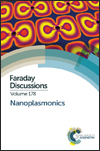High-density metallic nanogap arrays for the sensitive detection of single-walled carbon nanotube thin films
Abstract
We have investigated the extraordinary optical transmission of terahertz waves through an array of nanogaps with varying dimensions and periodicities, and used this platform to demonstrate terahertz sensing of a thin film of single-walled carbon nanotubes. We have used atomic layer lithography to fabricate periodic arrays of nanogap loops that have a gap size of 2 nm and a loop length of 100 μm (aspect ratio of 50 000). These sub-mm-scale loops of nanogaps can sustain terahertz electromagnetic resonances along the contour. We have characterized the transmission of terahertz waves through the nanogap arrays and investigated the influence of inter-gap electromagnetic coupling as the array periodicity shrinks from 100 μm to 4 μm. While the gaps occupy only 0.1% of the surface area, we have measured an amplitude (|E|) transmittance of over 50% due to the strong and broadband field enhancement inside the nanogaps. The absolute transmission through the 2 nm gaps along the rectangular loops can be boosted up to 25%, while it is only 1% for annular gaps with the same perimeter. Furthermore, the extremely tight field confinement and strong field enhancement near the 2 nm gap lead to 43% extinction of THz waves in a 10 nm-thick film of single-walled carbon nanotubes over the gaps. On the other hand, THz extinction by the same nanotube film on a bare glass substrate is only 2%. These nanogaps pave the way toward developing sensitive terahertz detectors for biological and chemical targets.
- This article is part of the themed collection: Nanoplasmonics

 Please wait while we load your content...
Please wait while we load your content...